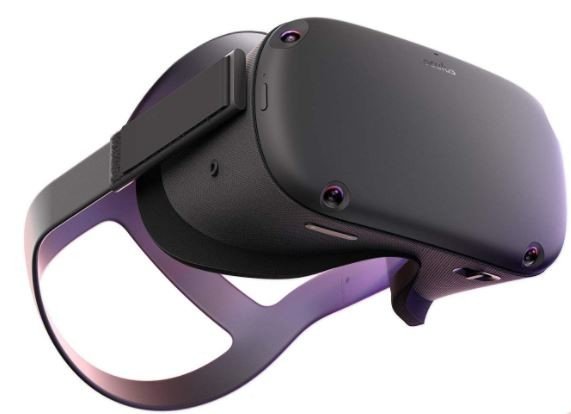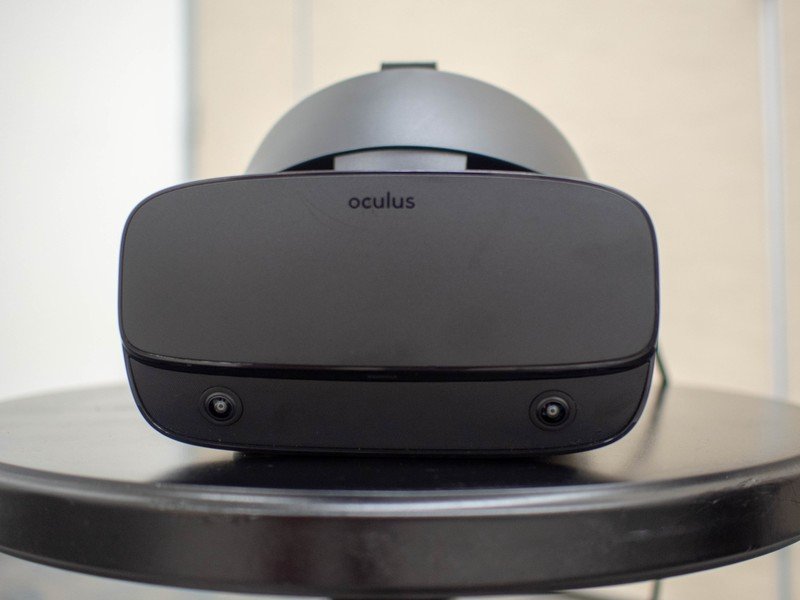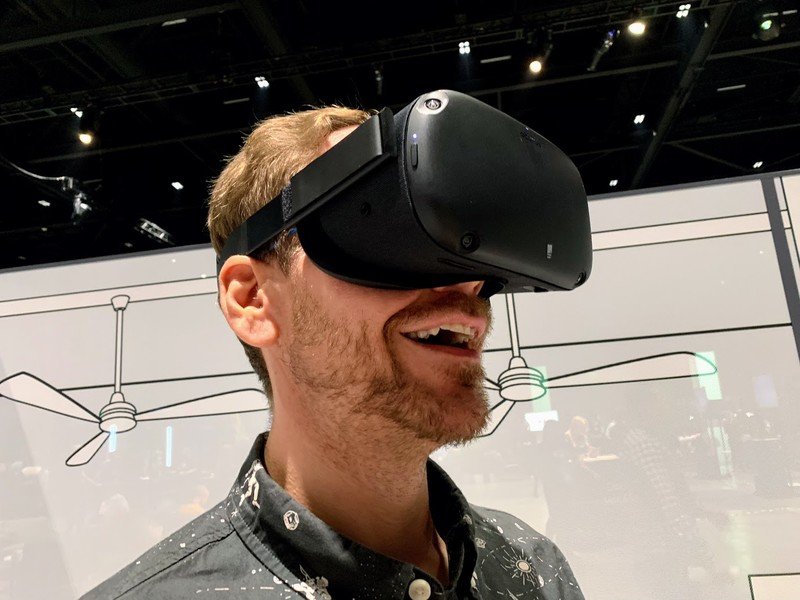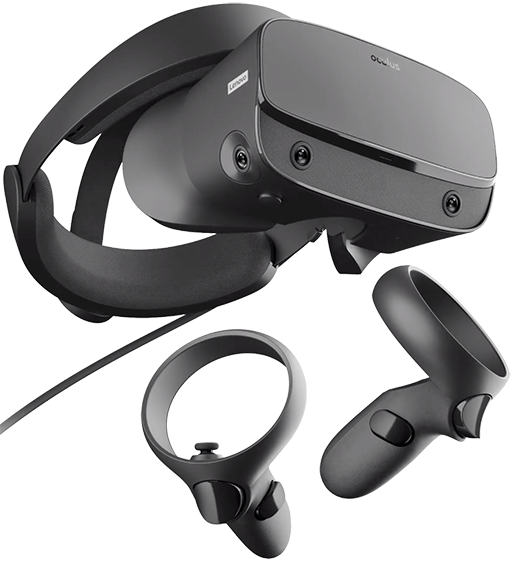Oculus Rift S vs. Oculus Quest: Which should you buy?
Oculus Quest

If you don't have a PC to power a VR headset, the Oculus Quest is no doubt the right pick. It's powered by a self-contained Snapdragon 835 processor (CPU) and has a higher resolution for its dual OLED displays. The IPD can be adjusted manually, allowing a broader range of users to find something comfortable.
Oculus Quest
Standalone VR headset
Oculus Rift S

The Oculus Rift S is a successor to the original Rift CV1, so it requires a connected PC to power it. Compared to the Oculus Quest, it uses a lower-res LCD. It doesn't have manual interpupillary distance (IPD) adjustment, but it does bring full access to original Rift titles, has an Insight tracking system with five sensors, and it offers a higher refresh rate at 80 Hz.
Oculus Rift S
PC-powered VR
Both of these VR headsets are going to deliver a stellar virtual experience, but the final decision will likely rest heavily on whether or not you have a PC ready to power VR. The Rift S still relies on external hardware to operate, while the Quest has everything built-in and doesn't have any external tether. The differences go deeper than that, though, which is what we examine here.
A significant change to note is the development of Oculus Link, which allows you to connect the Oculus Quest to your PC to play PCVR games. This feature dramatically changes the comparison between these two devices. If you want the best PCVR experience, you should grab the Oculus Rift S. If you want the versatility of a headset that can run as a standalone VR device or play PCVR titles, the Oculus Quest is a better choice.
Oculus Rift S vs. Oculus Quest: tech specs
Both VR headsets were released on May 21, 2019. Here's a breakdown of the tech specs that make up each system.
| Header Cell - Column 0 | Oculus Rift S | Oculus Quest |
|---|---|---|
| Display resolution | 2560x1440 LCD | 2880x1600 OLED |
| Refresh rate | 80Hz | 72Hz |
| IPD | Software | Manual |
| Audio | Integrated 3.5mm jack | Integrated 3.5mm jack |
| Tracking | Oculus Insight 5 sensors | Oculus Insight 4 sensors |
| Hand tracking | No | In preview |
| Degrees of freedom (DoF) | 6 DoF | 6 DoF |
| Controllers | Updated Touch | Updated Touch |
| PC requirements | Same as Rift CV1 | None (except when using Oculus Link for PCVR) |
| Cable | 5 meters DisplayPort 1.2 USB-A 3.0 | None |
| Price | $399 | From $399 |
Oculus Rift S vs. Oculus Quest: Display

The Rift S has a significant display update over the Rift CV1, ditching the deep blacks and light whites of dual OLED for a single LCD display. It has a combined resolution of 2560x1440 (1280x1440 for each eye) that is lower than the Quest's 2880x1600 resolution (1440x1600 for each eye).
Comparing the displays gets complicated because you can't just look at raw numbers in some cases. The Oculus Rift S uses an RGB stripe design compared to the Oculus Quest's diamond pentile design. In non-technical terms, the Oculus Rift S's screen appears clearer even though it has fewer pixels because of how it places pixels on its panel.
Get the latest news from Android Central, your trusted companion in the world of Android
Additionally, the Oculus Rift S has an LCD panel while the Oculus Quest has an OLED display. The OLED panel of the Oculus Quest offers deep blacks and high contrast, but the LCD panel of the Oculus Rift S has a faster refresh rate (80Hz vs 72Hz).
Both the Rift S and the Quest deliver a picture that has less screen-door effect (SDE) than older models, meaning you won't see as much of a grid over the presented picture when you focus firmly on the display. However, you'll likely still see more god rays with the Quest than the Rift S.
Perhaps the biggest complaint many users will have about the Rift S is that IPD adjustments are handled by software. IPD is the distance between your pupils, and being able to manually set it with a slider — like on the Rift CV1 and Quest — opens the headset up to a lot more users. There is some sway with the Rift S thanks to software, but if your eyes aren't in the common distance spacing, you will have a much tougher time getting a perfect view. The Quest, on the other hand, lets you adjust IPD with a slider, giving you a much better chance of getting a perfect view even if your eyes have uncommon spacing.
While the Oculus Quest has a fine display, the Rift S is considered the better of the two when looking at all the elements that make up displays.
Oculus Rift S vs. Oculus Quest: Design

The Oculus Quest more closely resembles the Rift CV1 than the Rift S, no doubt due to the Rift S being designed with help from Lenovo, which has its own line of Windows Mixed Reality (WMR) headsets. The Rift S brings a halo headband with a dial on the back to get the right tightness and the headset kind of hangs down over your face. There's still a band that runs along the top of your head to keep it from slipping down.
The Quest sticks with a headband like the Rift CV1 had, with dual Velcro adjustments on either side and a top strap to keep the headset from slipping down. The design means the display is stuck straight onto your face instead of hanging down, and comfort-wise it doesn't quite compare to the Rift S. The Quest has four sensors — one in each corner of the front plate — with no bottom ledge like on the Rift S, giving it an authentic Oculus look.
Both headsets have gone the route of integrated audio. There are no longer headphones or earbuds hanging down off of the headband, as we saw on the Rift CV1. Instead, audio feels like it comes out of nowhere. Speakers are embedded in the headband and don't touch your ears, so if you want better immersion and to cut out external audio completely, you can plug in third-party headphones to the devices' 3.5mm audio jacks.
Oculus Rift S vs. Oculus Quest: Performance hardware

The Rift S is a PC-powered experience, meaning you'll still have a tether back to your computer. The tether is five meters long, compared to four on the Rift CV1, so you get a bit of extra leeway, but it does rely on DisplayPort instead of HDMI. Luckily, because the Rift S uses the same core software as the Rift CV1, system requirements haven't really changed other than the required video port. If you have a PC with an NVIDIA GTX 1060 or AMD Radeon R9 480 graphics card (GPU), you're already hitting the recommended specs, though better hardware will give you the best experience possible. If you're interested in extending your Rift S cables, you can do so successfully for about $15.
Unlike the Rift S, the Oculus Quest is a self-contained VR headset. There's no cable back to a PC, and all performance hardware is housed with the display and lenses. This makes the Quest a lot more portable and gives you a lot more freedom, though the Snapdragon 835 processor (CPU) understandably won't deliver the same performance as a full gaming PC. This means that the current Oculus Rift library won't be available on the Quest, though it's safe to assume that a lot of popular titles will be available on the standalone headset.
A significant factor when comparing these two headsets is the Oculus Link, which allows you to play PCVR games on your Oculus Quest by connecting it to your PC. The feature works best with an expensive cable, and greatly expands the versatility of your Oculus Quest.
If you have a PC capable of powering VR games, you'll be able to play them on your Oculus Quest. This means that the Oculus Quest can be a portable VR headset that you can easily take around with you or a wired PCVR headset. It won't provide as good of a PCVR experience as the Rift S due in part to its display appearing worse, but it's tremendously more versatile.
Oculus Rift S vs Oculus Quest: Tracking and touch

Both headsets feature the new Oculus Insight tracking system, which works with built-in cameras and sensors on the headset itself. Insight scans your surroundings and identifies physical objects in space, and combines it with data from the headset's accelerometer and gyroscope, giving your exact positional data once per millisecond. You won't need any external sensors with either headset.
Oculus Quest uses four sensors, one in each corner of the headset, for tracking, while the Rift S relies on five, with two on the front, two on the side, and one on the top of the headset. Some of the tracking issues we experienced when testing the Quest weren't apparent with the Rift S thanks to the different positioning, so if you plan on playing a lot of games where perfect tracking matters, the Rift S might give you a slight edge.
You'll get the updated Oculus Touch controllers with either headset, which have been refined for better tracking and more intuitive button placement. Both VR systems bring six degrees of freedom (6DoF) to the table, meaning you can move naturally in three-dimensional space and have it all translate into whatever experience you're enjoying.
Everything you can do with Oculus Quest hand tracking
Another feature that came out after these headsets were released is hand tracking for the Oculus Quest. This feature allows you to control menus and some select games without a Touch Controller. This feature will become more valuable over time as developers adopt it. You can check out our collection of the best hand tracking games for Oculus Quest to find titles that already support the new feature.
Hand tracking is not available for the Oculus Rift S, though that could potentially change in the future.
Software updates give the edge to the Oculus Quest
If you want the absolute best PCVR experience on the Oculus platform, your best bet is the Oculus Rift S, but software updates and upcoming features make the Oculus Rift S harder to recommend over the Oculus Quest. With Oculus Link, the Oculus Quest delivers PCVR when tethered and mobile VR when you're on the go.
Additionally, the Oculus Quest has hand tracking and a growing library of dedicated Oculus Quest games. Despite being out for a while, the Oculus Quest is getting significantly better over time. While the Oculus Rift S is a lovely headset for PCVR, the Oculus Quest gets our recommendation thanks to its mobility, versatility, and upcoming features.

The Oculus Quest delivers an untethered VR experience with 6 degrees of freedom and two Touch Controllers. It's an easy way to jump into VR because it doesn't require a PC. If you do have a gaming PC, Oculus Link is currently in beta and allows you to play PCVR games through your Oculus Quest when connected to a PC.

The next evolution of the Rift brings improved lenses, a display with a higher pixel count than the original, and a redesigned head strap and tracking system, but you're still tethered to a PC. If you want the absolute best PCVR experience on the Oculus platform, this is your best option.

